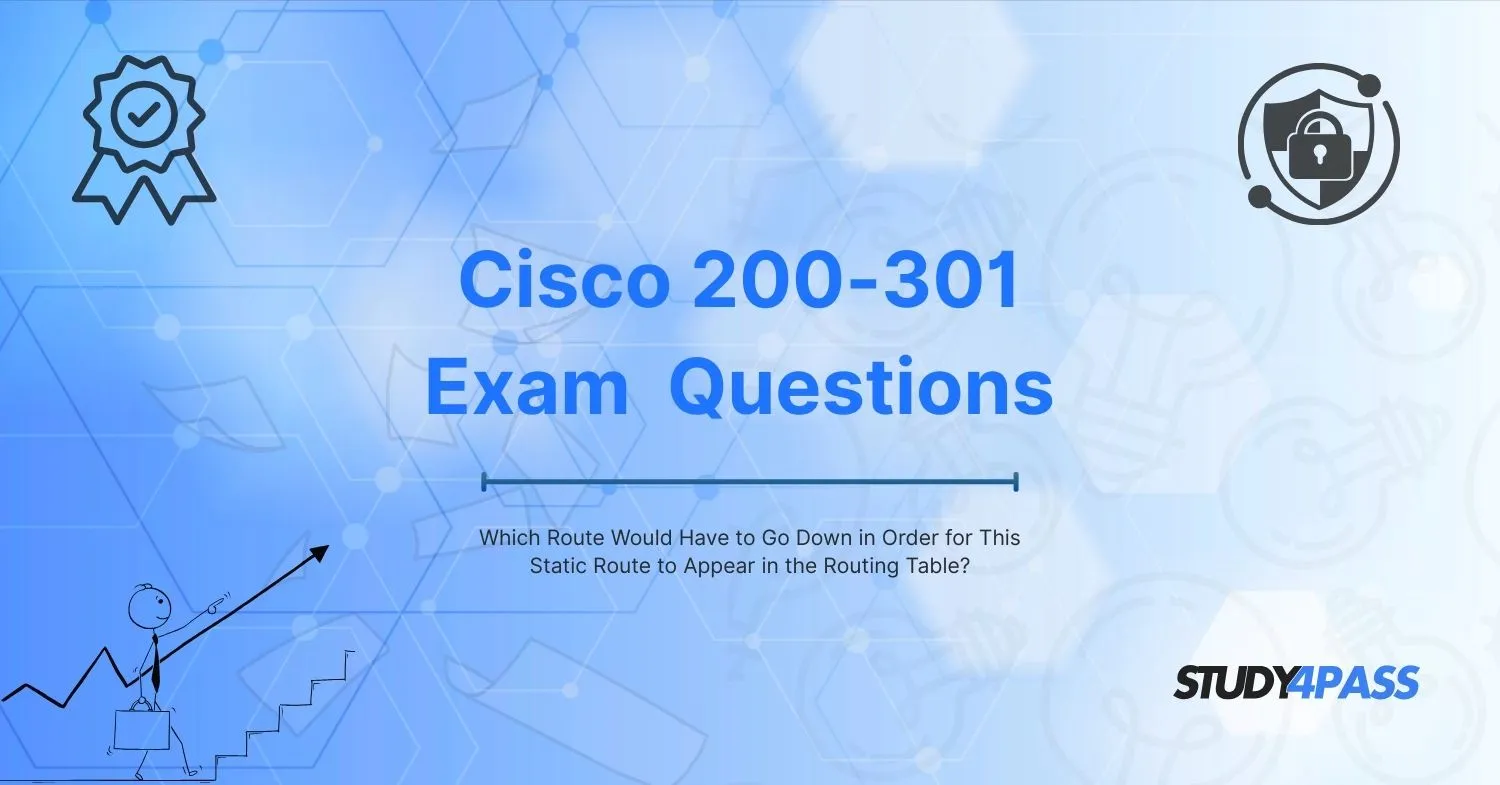Introduction To Cisco 200-301 Exam Actual Questions
Preparing for the Cisco 200-301 exam requires a deep understanding of networking concepts, including static and dynamic routing. One common question that arises is: "Which route would have to go down in order for this static route to appear in the routing table?" This is a critical topic for anyone aiming to pass the CCNA 200-301 exam and master network routing configurations.
In this blog, we will explore:
- The role of static routes in routing tables
- How administrative distance (AD) affects route selection
- Scenarios where a static route becomes active
- Practical examples with Cisco 200-301 exam actual questions
By the end, you'll have a clear understanding of when and why a static route appears in the routing table, helping you tackle similar questions in the Cisco 200-301 Exam Actual Questions.
Understanding Routing Tables and Static Routes
What Is a Routing Table?
- A routing table is a database stored in a router that contains information about:
- Directly connected networks
- Remotely learned networks (via dynamic routing protocols like OSPF or EIGRP)
- Statically configured routes
The router uses this table to determine the best path for forwarding traffic.
What Are Static Routes?
Static routes are manually configured routes that define a specific path for traffic. Unlike dynamic routes (learned via protocols like OSPF or RIP), static routes do not change unless modified by an administrator.
Example of a Static Route:
- ip route 192.168.1.0 255.255.255.0 10.0.0.2
- This command tells the router:
- Destination Network: 192.168.1.0/24
- Next-Hop IP: 10.0.0.2
When Does a Static Route Appear in the Routing Table?
A static route only appears in the routing table if:
1. The next-hop IP is reachable (the router can ping it).
2. No better route exists (based on Administrative Distance).
Key Concept: Administrative Distance (AD)
Administrative Distance (AD) is a measure of trustworthiness of a route. Lower AD values are preferred.
|
Route Type |
Administrative Distance |
|
Directly Connected |
0 |
|
Static Route |
1 |
|
EIGRP |
90 |
|
OSPF |
110 |
|
RIP |
120 |
Scenario: When a Static Route Takes Over
Imagine a router has two possible paths to a network:
1. Dynamic Route (OSPF, AD = 110)
2. Static Route (AD = 1)
The router will always prefer the static route because of its lower AD. However, if the static route’s next-hop becomes unreachable, the router will fall back to the OSPF route.
Exam-Style Question:
Which route would have to go down in order for this static route to appear in the routing table?"
Answer:
- The static route will appear only if the currently active route (with a higher AD) fails. For example:
- If an OSPF route (AD=110) is currently in the routing table, the static route (AD=1) will only appear if the OSPF route goes down.
- If a directly connected route (AD=0) exists, the static route will never appear unless the connected interface fails.
Practical Example: Static Route Activation
Let’s consider a real-world scenario:
Network Topology:
Router A has two paths to Network X:
Path 1: OSPF-learned route (AD = 110) via Router B
Path 2: Static route (AD = 1) via Router C
Current Routing Table:
- O 192.168.1.0/24 [110/20] via 10.0.0.2
- S 192.168.1.0/24 [1/0] via 10.0.0.3 (inactive)
What Happens If the OSPF Route Fails?
1. Router A detects that the OSPF route is no longer available.
2. The static route (with AD=1) is now the best available path.
3. The static route appears in the routing table and traffic flows via Router C.
How This Applies to the Cisco 200-301 Exam
The Cisco 200-301 Certification frequently tests your understanding of:
- Route preference (AD values)
- Static vs. dynamic route behavior
- Troubleshooting routing issues
Sample Exam Question:
Q: A router has the following routes for 192.168.5.0/24:
- A static route (AD=1) via 10.1.1.1
- An OSPF route (AD=110) via 10.2.2.2
Which route will be active, and under what conditions will the static route take over?
Conclusion
Understanding when a static route appears in the routing table is crucial for the Cisco 200-301 exam. Remember:
1. Static routes (AD=1) are preferred over dynamic routes (e.g., OSPF, RIP).
2. A static route only appears if no better (lower AD) route exists.
3. If a higher AD route fails, the static route becomes active.
Special Discount: Offer Valid For Limited Time “200-301 Exam Prep Practice Test”
Sample Questions for Cisco 200-301 Exam
Actual exam question from Cisco's 200-301 Exam Prep Practice Tests
Which protocol is used by an IPv6-enabled host to automatically configure its own link-local address?
A) DHCPv6
B) ARP
C) ICMPv6
D) NDP (Neighbor Discovery Protocol)


